 |
||
|
||
| ||
 Time flies by, IT industry is rapidly developing, especially 3D accelerators. Their power and capabilities have markedly improved over the past 5 years. 5 years ago, in 1998 we got the unexampled 3dfx Voodoo2. It was a separate video card supporting 3D modes only. It had to be installed together with a 2D card. At that tome the market could offer few combo 2D/3D accelerators: NVIDIA Riva 128 and ATI RAGE/II/Pro. There were some other attempts to combine 2D and 3D even in a single chip, but they were unpopular, in contrast to the successful 3dfx Voodoo Graphics (it was also a separate 3D accelerator). Another noticeable solution was Matrox M3D on the first PowerVR product. Let me quote an abstract from a once popular review (actually the first one) from Reactor Critical written by Konstantin Martynenko AKA Kenguru, founder of this site: "Finally I got Voodoo. Permedia 2 and Riva 128 based cards were not new on the market, but PowerVR was a new-comer. It had to come to the scene anyway due to the fame of Matrox, whose products are brought to Moscow by many computer firms. Matrox released a PowerVR PCX2 based card and gave it a plain name of m3D.Do you feel nostalgic? Isn't it the naivety that people have when excitedly start something new and feel, in every fiber, good prospects of this sphere? We all started something... Sometimes I reread my first reviews to get relaxed because they make me smile... :-) "I haven't seen a "live" Diamond Monster 3D II, but I'd like to see how Diamond rearranged the chips so that they heat less (it was the official reason to delay the Diamond's 3Dfx Voodoo2 accelerator). I have a special fan in the PC case for all PCI cards (I had to use it for Riva 128 video cards as well, as they quickly raise their temperature). When I switched it on, the tests were flawlessly passed several times, and Forsaken DEMO was run some 15 times.That was all about Matrox G200... We even had a meeting with Konstantin (on the right on the photo below) to reach a consensus because the views were entirely different.  It's taken from the materials of 1997-1998. But I'm not going to turn today's article into recollection about former favorites. It's very interesting to compare at least once performance of the former leaders and famous 3D accelerators on modern applications with graphics cards of latest generations. Obviously, far not all old 3D accelerators are able to work on modern platforms, and first of all, because of the AGP 3.0 standard which cuts off all cards unsupporting 1.5V power supply. It covers almost all 3dfx video cards (when the company started making cards itself). As you might know, we have a museum of computer equipment, and many video cards get there as exhibits (they remained after tests, or they were gifts from friends; there are quite rare things). Unfortunately, we don't have all 3D accelerators for PC in our museum, but the list of cards is pretty lengthy. Fortunately, many cards are still operable and can be tested. Our 3Digest monthly covers 32-34 graphics cards. The list of them is regularly updated, and accelerators, which have no support, or drivers for them are rarely released, or monthly retesting makes no sense, or drivers do not boost performance or cope with bugs, go to the archive. Today we decided to fish some cards out of the archive and test together with modern cards which are still covered by 3Digest. But it's impossible to test all the samples from the archive because:
But do not worry, - our second Retro review will deal with all the accelerators on the old platform based on i440BX and 233MHz Pentium II. It will be an opposite picture: performance of modern accelerators on an old platform. Below is a list of the accelerators we tested and wanted to test but couldn't because of the AGP limitation (the red cross on the photos means that a given card is dead for new platforms). Some of them were described in our 3Digests (the link will be given in this case). 1998i740 4MB When first rumors about this accelerator reached the market, it was predicted more fame and twice better performance than even that of Riva 128 had... The reality was more prosaic. But this accelerator found its niche. It was backed by Intel... The chip is presented by Diamond Multimedia's card. NVIDIA Riva 128 4MB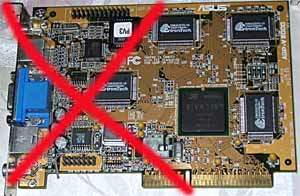 ASUSTeK's video card. 3dfx Voodoo2 SLI 24MB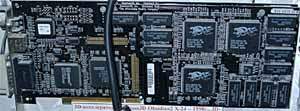 The dual accelerator serves a base for Quantum3D's Obsidian2 X-24. Why dual? - Because we tested the cards in 1024x768, which is not supported by the single Voodoo2. NVIDIA RivaTNT 16MB The chip is represented by ASUSTeK's card. 1999NVIDIA RivaTNT2 M64 32MB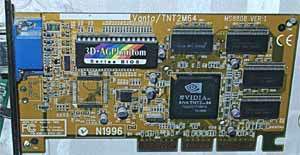 MSI's card. This is actually one of the rarest cases when TNT2 M64 works on modern platforms. NVIDIA RivaTNT2 Ultra 32MB Hercules's card. It doesn't work on i7205. 3dfx Voodoo3 16MB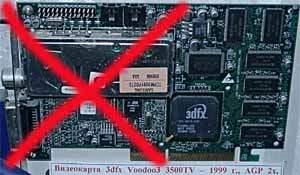 This is a flagship of the Voodoo3 line - Voodoo3 3500TV. But all these cards are only AGP 1.0 certified! 3dfx Velocity100 8MB That was the favorite product of summer 1999! It was a cheap but effective card... Now it's only an exhibit. S3 Savage4 32MB This is an 3D idol of a myriad of budget-concious users! It was a large aggressive community that combated those who didn't want to use drivers mixing, S3Tweak utility and regularly reflash new BIOS versions to make performance satisfactory. One can still compose legends on the Savage... The forefather of S3TC texture compression technology (it appeared yet in Savage3D in 1998, but at that time S3TC drew no attention at all). Matrox G400 32MB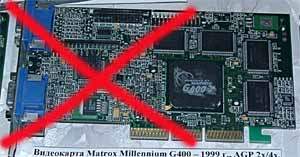 Matrox's card. ATI RAGE 128 PRO 32MB At that time the Canadian company made cards alone, that is why this chip comes on its own card. S3 Savage 2000 32MB It was a significant product: after the tough criticism of Savage4 its fame was fading away but the Savage2000 pushed it up again, and that card was tweaked multiple times. But it didn't help S3 as a GPU maker. The Savage4/2000 floated just a little after 1999 thanks to the drivers mixing. 2000ATI RAGE MAXX (2 x RAGE 128 PRO) 64MB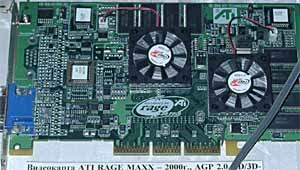 Born dead. While the card performed pretty well in Windows 98, it failed in Windows 2000 (not to mention Windows XP) because of lacking drivers (ATI then admitted impossibility to write drivers for NT systems). Later, the support for Windows 9x was withdrawn. NVIDIA GeForce2 GTS 32MB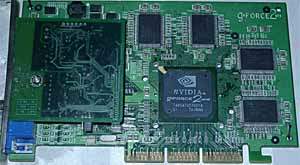 AOpen's card represents this chip. NVIDIA GeForce2 Pro 64MB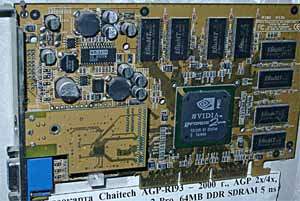 This GPU comes on Chaintech'a card. NVIDIA GeForce2 MX200 32MB Gigabyte'a card. NVIDIA GeForce2 MX400 32MB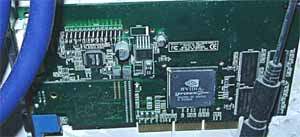 NVIDIA's reference card on GeForce2 MX which was overclocked up to the level of MX400 - 200/183 MHz. 3dfx Voodoo4 4500 32MB 3dfx Voodoo5 5500 64MB ATI RADEON 32MB SDR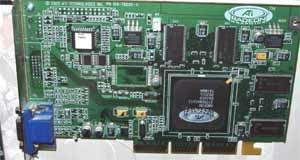 ATI's card. ATI RADEON 64MB DDR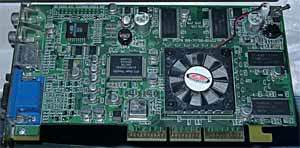 The same. SIS 315 128MB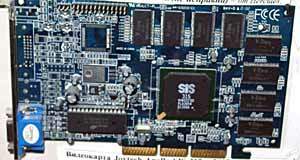 Joytech'a card. PowerVR/STM KYRO 32MB Hercules card. 2001NVIDIA GeForce3 64MB NVIDIA's reference card. NVIDIA GeForce3 Ti200 64MB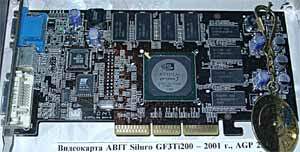 ABIT'a card. PowerVR/STM KYRO II 32/64MB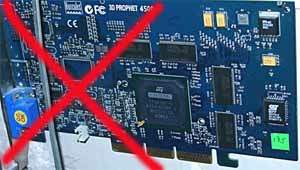  Matrox G550 32MB DDR This "new old" product ships on the Matrox's card. ATI RADEON 7500LE 64MB DDR Jetway's card. ATI RADEON 7500 64MB DDR ATI's card. ATI RADEON 8500 128MB DDR 3.6ns HYNIX (275/550 MHz)
ATI RADEON 8500 64MB DDR 3.6ns (275/550 MHz)
ATI RADEON 8500LE 64MB DDR 3.6ns (250/500 MHz)
ATI RADEON 8500LE 128MB DDR 4ns (250/500 MHz)2002Trident Blade XP 32MB HIS card. S3 Savage XP 32MB This is a demo card, i.e. a graphics card on the early silicon (T&L, for example, doesn't work here). Production of such cards weren't even started. PowerVR/STM KYRO II SE 64MB Hercules's card. The same product. Actually dead. NVIDIA GeForce4 MX 440 64MB eVGA'a card. NVIDIA GeForce4 MX 440 with AGP8x 64MB DDR 3.6ns (275/513 MHz)NVIDIA GeForce4 MX 440 with AGP8x 128MB (280/520 MHz)NVIDIA GeForce4 MX 440 with AGP8x 64MB GS (300/600 MHz)NVIDIA GeForce4 Ti 4200 64MB DDR 4ns (250/513 MHz)NVIDIA GeForce4 Ti 4200 128MB DDR 4ns (250/444 MHz)NVIDIA GeForce4 Ti 4200 128MB DDR 3.3ns (250/550 MHz)NVIDIA GeForce4 Ti 4200 128MB DDR 4ns (250/500 MHz)NVIDIA GeForce4 Ti 4200 with AGP8x 128MB DDR 4ns (250/513 MHz)NVIDIA GeForce4 Ti 4200 with AGP8x 128MB DDR 2.8ns (275/600 MHz)NVIDIA GeForce4 Ti 4600 128MB DDR 2.8ns (300/650 MHz)NVIDIA GeForce4 Ti 4600 GS 128MB DDR 2.8ns (310/680 MHz)ATI RADEON 9000 64MB DDR 4ns (250/400 MHz)ATI RADEON 9000 128MB DDR 3.6ns (250/400 MHz)ATI RADEON 9000 Pro 128MB DDR 3.6ns (275/550 MHz)ATI RADEON 9000 Pro 64MB DDR 3.6ns (275/550 MHz)ATI RADEON 9500 64MB 3.6ns (275/540 MHz)ATI RADEON 9500 128MB 3.6ns (275/540 MHz)ATI RADEON 9500 PRO 128MB 3.6ns (275/540 MHz)ATI RADEON 9700 Pro 128MB DDR 2.8ns (325/620 MHz)ATI RADEON 9700 128MB DDR 2.8ns (275/540 MHz)SIS Xabre 400 64MB DDR 3.5ns (250/500 MHz)SIS Xabre 400 128MB DDR 4ns (250/500 MHz)SIS Xabre 600 64MB DDR 4ns (315/630 MHz)Matrox Parhelia 128MB DDR 3.3ns (220/550 MHz) (Retail)2003NVIDIA GeForceFX 5800 Ultra 128MB DDR2 (500/1000 MHz)NVIDIA GeForceFX 5800 128MB DDR2 (400/800 MHz)
NVIDIA GeForceFX 5600 Ultra 128MB DDR (350/700 MHz)
NVIDIA GeForceFX 5200 Ultra 128MB DDR (325/650 MHz)
ATI RADEON 9200 64MB DDR 4ns (250/400 MHz)
ATI RADEON 9800 Pro 128MB DDR (380/680 MHz)TestsTestbeds:
VSync off in drivers, texture compression off in applications. Texture detail set to High Quality. Test applications:
|
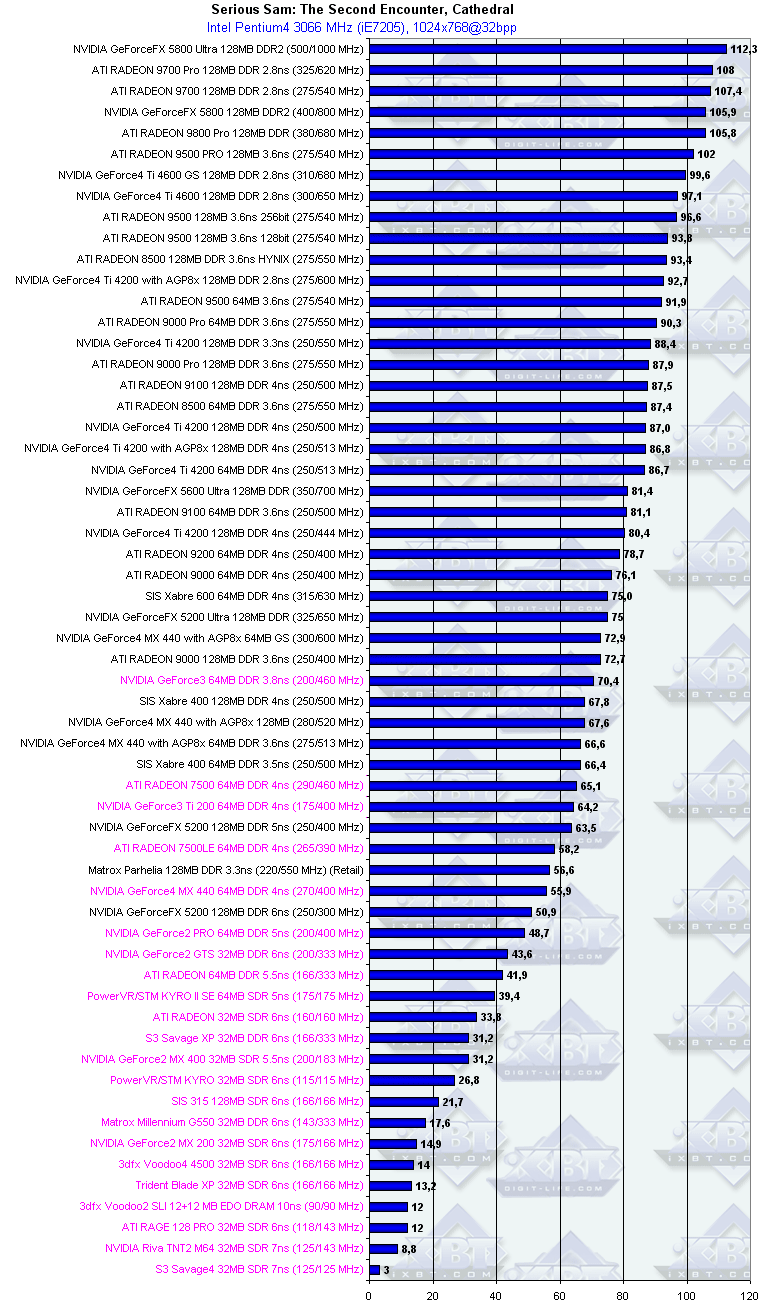

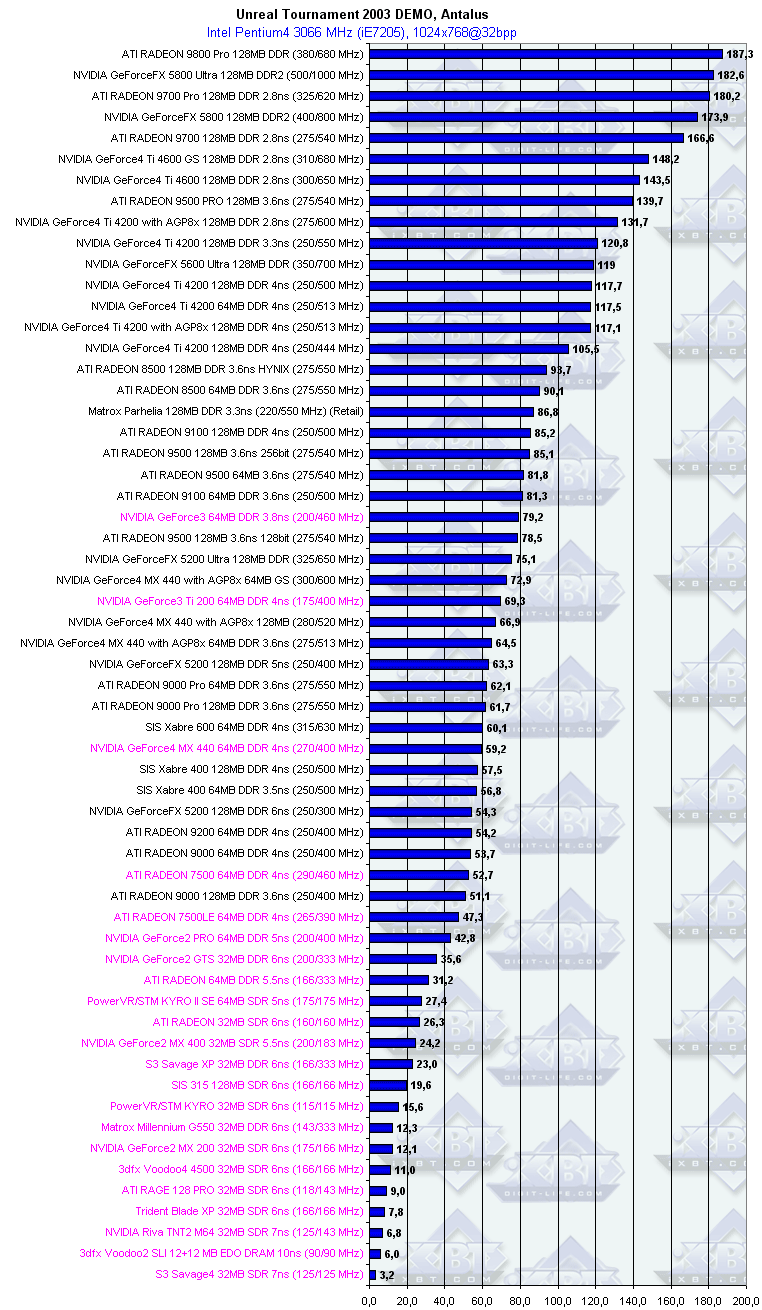
Why didn't we test the cards in 800x600? As you can see, most powerful accelerators are limited by the system resources yet in 1024x768; in 800x600 1/3 of the cards will have equal scores :-). Besides, it's 2003. Retro is a good thing, but gamers prefer 1024x768 and higher.
Actually, all cards removed from 3Digest and simply obsolete accelerators (they are marked lilac on the diagrams) are at the bottom. Only some of them perform more or less well (for example, GeForce3, but it was taken out of production long ago, and vendors are selling out remains from stocks).
This material is a once-only action, and I ask you not to wait for regular
reviews of old graphics cards :-).
Write a comment below. No registration needed!
|
Article navigation: |
| blog comments powered by Disqus |
| Most Popular Reviews | More RSS |
 |
Comparing old, cheap solutions from AMD with new, budget offerings from Intel.
February 1, 2013 · Processor Roundups |
 |
Inno3D GeForce GTX 670 iChill, Inno3D GeForce GTX 660 Ti Graphics Cards A couple of mid-range adapters with original cooling systems.
January 30, 2013 · Video cards: NVIDIA GPUs |
 |
Creative Sound Blaster X-Fi Surround 5.1 An external X-Fi solution in tests.
September 9, 2008 · Sound Cards |
 |
The first worthwhile Piledriver CPU.
September 11, 2012 · Processors: AMD |
 |
Consumed Power, Energy Consumption: Ivy Bridge vs. Sandy Bridge Trying out the new method.
September 18, 2012 · Processors: Intel |
| Latest Reviews | More RSS |
 |
Retested all graphics cards with the new drivers.
Oct 18, 2013 · 3Digests
|
 |
Added new benchmarks: BioShock Infinite and Metro: Last Light.
Sep 06, 2013 · 3Digests
|
 |
Added the test results of NVIDIA GeForce GTX 760 and AMD Radeon HD 7730.
Aug 05, 2013 · 3Digests
|
 |
Gainward GeForce GTX 650 Ti BOOST 2GB Golden Sample Graphics Card An excellent hybrid of GeForce GTX 650 Ti and GeForce GTX 660.
Jun 24, 2013 · Video cards: NVIDIA GPUs
|
 |
Added the test results of NVIDIA GeForce GTX 770/780.
Jun 03, 2013 · 3Digests
|
| Latest News | More RSS |
Platform · Video · Multimedia · Mobile · Other || About us & Privacy policy · Twitter · Facebook
Copyright © Byrds Research & Publishing, Ltd., 1997–2011. All rights reserved.